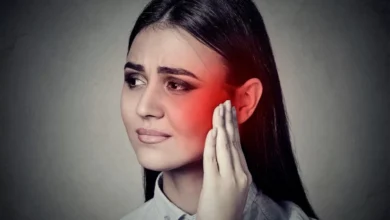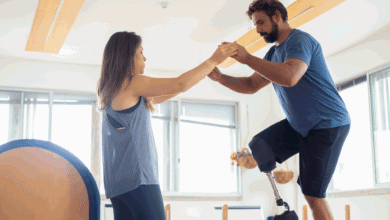What If Physical Therapy Doesn’t Work? Guide

Physical therapy, though a common treatment for pain and injuries, can still not work for some people. The reason behind this is that the body’s nature is such that even if it is given treatment, certain muscles will still not be able to function even if they get communicated to. Here are various reasons why physical therapy might not be working for you and what if physical therapy doesn’t work?
If you’ve ever looked for a physical therapist, you are aware of the high demand for professionals in the field of physical medicine and rehabilitation. You may have searched for “how physical therapy works” or “what causes physical therapy to not work?” There are many factors that can play a role in this decline
What Causes Physical Therapy to not Work?
A well-done physical therapy solves a number of health issues but physical therapy might not bring fruits for you if done incorrectly. Here are some reasons why physical therapy might not be working for you:
01. Muscle weakness due to a lack of exercise or atrophy.
Physical therapy won’t work because the patient’s muscles are weak and they need to be strengthened, not stretched or lengthened, or if the patient has already had muscle surgery. It might not work because of Muscle weakness due to a lack of exercise or atrophy. Physical therapy will only work if the muscles are strong enough to get it done, and sometimes even then it doesn’t take that much for the muscles to get stronger.
Physical therapy doesn’t work if you are too weak to move your body at all, or have any kind of nerve damage. It will also not help if you have had surgery on your spine and cannot move around well without pain or injury.
02. Joint instability and poor posture.
Joint instability is a condition in which one or more joints are not working properly. It can be caused by muscles that are too tight or muscles that are too weak.
Poor posture is when your body is in an incorrect position, such as slouching over a computer or slumped over at a desk. Your body doesn’t stay in the correct position for long enough to allow. One of the most common reasons people do not get better is that they don’t do the exercises correctly, or they have poor posture. If you have joint instability (a term for when your muscles can’t hold your joints in place), then your body will compensate for it by making other muscles stronger or by tightening up. This is why many people who complain about their back pain also say that it hurts when they sit or stand up straight.
When you have poor posture, can lead to further injury down the road. It’s like having a car with badly maintained tires and brakes that don’t work well together – they may not be causing problems right now, but one day you’ll crash into something when pulling out of the driveway after a long night at the bar (or whatever). the tissues to heal.
03. Lack of adequate nutrition.
Physical therapy won’t work because of a Lack of adequate nutrition. In order to heal, your body must have enough energy to repair itself. When you are not getting enough nutrients your body can’t repair itself and so it goes on to break down more tissue in order to make up for this lack of nutrients.
The body needs fuel to heal itself, and it can’t do so if it doesn’t have enough nutrients to feed its cells and repair damage. If you have been sick for a long time, your body may be depleted of nutrients and may need an adjustment in its diet to get it back on track again.
04. Overuse injuries/muscle soreness/pain.
Overuse injuries are those that occur repetitively or continuously over time. These types of injuries can become chronic, especially if they are left untreated. They can also cause inflammation in the surrounding area which can lead to pain and stiffness in muscles or joints.
Muscle soreness is the result of intense exercise and results in sore muscles after you stop exercising for a period of time. It’s important to be aware that this type of injury is temporary because it will go away once you stop exercising for a while and start again with other types of activities.
Pain is another condition that physical therapy won’t help with since it is caused by something outside your body (such as an injury). If you have pain but don’t know what caused it, then there is no way for your doctor or physical therapist to treat it effectively using only physical therapy techniques. If you’ve got muscle soreness or pain from overuse, physical therapy won’t help either. These kinds of injuries are typically caused by repetitive movements that stress your muscles beyond their limits. In these cases, it’s best to take some rest and let the body heal itself before trying physical therapy again.
05. Bad habits you may not even be aware of.
Physical therapy won’t work if you don’t take care of the problem. The physical therapist will not be able to help you if you don’t change your bad habits. Physical therapists aren’t miracle workers, they can only help you move in ways that are safe and effective for you. If you have a bad habit that is causing pain and discomfort, then it’s time to stop doing it!
The most common reason a person will not get better following physical therapy is that they have developed bad habits. They might be doing things wrong and not realizing it.
You need to change your lifestyle first and then address the pain in your body. Follow these steps:
- Stop doing what is causing the problem, whether it is overuse or underuse of muscles, poor posture, or stress on joints.
- Make some changes in your daily activities to help prevent problems in the future, such as watching what you eat, taking more breaks throughout the day, getting plenty of sleep, and making time for restorative exercises like yoga or massage therapy after a long day at work or school.
- If you are injured, talk about it with your doctor so that he or she can help you understand how to avoid future injuries by using proper techniques when lifting weights or playing sports and how to prevent other injuries from occurring if they do occur.
06. Your Physical Therapist
If you are a patient of physical therapy, there are many reasons why physical therapists might be the reason that physical therapy won’t work.
- The most common reason why physical therapists don’t work is that they are not trained to do the job. They are trained to treat patients with injuries, but not the general population of people who have pain related to their bodies.
- The second reason why physical therapy won’t work is that they know how to treat one type of problem and they don’t know how to treat other problems. They may be good at treating certain types of injuries, but may not know anything about treating other issues such as stress or anxiety, or depression.
- The third reason why physical therapy won’t work is that your therapist does not have enough time for you. You might need a lot more time than your therapist can give you, so this will not be an effective treatment for your condition.
Takeaway
There are several reasons why physical therapy may not seem to be working. Here are some of the most common reasons for not seeing progress in your physical therapy:
- A poor therapist or program – The quality of your care is often a key factor in whether you see improvement. If you find that your therapist isn’t knowledgeable about the techniques and exercises they are prescribing, ask for another therapist who understands how to get results faster. If this is not possible, consider switching programs or moving to another facility where that specializes in the specific problem area you need treatment for. Here are signs of a bad Physical therapist.
- Lack of motivation – This is one of the most common reasons people stop seeing results in their physical therapy program. If you aren’t motivated by the exercises being prescribed or if you feel like they aren’t helping, try different approaches or set goals that are more motivating to get started again.
- Injury reoccurrence – If your injury has gotten worse over time, then it may be time to take a break from physical therapy until it heals completely again. Trying too hard can cause injuries to relapse and stop healing altogether
What if physical therapy doesn’t work in old patients
If you are an older adult and physical therapy doesn’t seem to be working, there are some things that can be done to improve the situation. First of all, it is important to make sure that the person receiving physical therapy is following through with all of their exercises. The therapist should also make sure that they have a good relationship with the patient and are able to communicate well with them. If this is not possible, then the therapist should find someone else who can help them out.
If physical therapy does not seem to be working for your loved one, there are other ways of improving the situation. The first thing that you should do is find out why it is not working. There may be a reason why it is not working and you need to figure out what it is so that you can fix it. Once you know what needs to be fixed, then you can work on fixing it right away and get your loved one back on track with physical therapy as soon as possible.
If they have been going for several weeks or months without any progress being made, then it might be time for them to seek professional help from someone else who specializes in working with older adults who have health issues like arthritis or joint.
What to Do if Physical therapy isn’t Working
Talk to the physical therapist (PT)
If you’re not getting better, it’s time to talk to a physical therapist (PT). Don’t be afraid, to be honest, and don’t feel like you have to wait until you are completely healed before you bring up the issue.
The best way to get started is by having an initial conversation with your PT about what has been going on, how much longer it will take for you to get better, and any concerns or questions you have about how progress is being made.
You should also ask your PT if there are any changes they can make in their treatment plan that would help speed up your recovery.
Communicate with the doctor
If physical therapy doesn’t work, you’ll want to find out why. The doctor may have prescribed physical therapy for the wrong reason. Or, the doctor may have prescribed physical therapy for the right reason but you may not be flexible enough or strong enough to do it. If this is the case, then it’s important to communicate this with your doctor and ensure that he or she knows exactly what you can and cannot do.
If your doctor thinks that physical therapy will help but you don’t think so, then go back to him or her and explain why. Try to get some ideas of what else might be wrong with your body and how physical therapy could help with that issue as well.
If physical therapy doesn’t help, you can ask the doctor why he or she was unable to help you. Your doctor may recommend other treatments, such as injections or medications, that are not covered by insurance.
Try another Physical Therapist
If Physical Therapy doesn’t work, try another Physical Therapist. The first physical therapist may not have the proper skills to treat your problem. You might have found a bad physical therapist, here is how you can find a good physical therapist for you.
If you don’t feel like you’re getting any better, ask for a second opinion from a different physical therapist. You can get a second opinion from the same dispensary or a different one that specializes in sports medicine like Sports Medicine Specialists or Premier Physical Therapy.
Ask about home exercises
If you are not getting the results you want, ask your physical therapist about some of these home exercises. For example, if you have weak hip muscles, do a leg lift every day before you go to bed. This will help strengthen your hip muscles and prevent back pain in the future.
If you have chronic pain from an injury or after surgery, then home exercises may be able to help you feel better without having to go through more physical therapy. There are many different types of exercises you can do at home that can help improve your range of motion and decrease pain.
Home exercises include:
- Aiming for 30 minutes of cardiovascular exercise per day (such as walking)
- Flexibility exercises (such as stretching)
- Stretching exercises (such as yoga)
- Exercises that focus on specific areas of your body such as core strengthening or neck stretches
Read up on alternative treatments
Physical therapy is an effective treatment for many people with low back pain. But there are alternatives to consider before you give up on physical therapy.
If you’ve been told by your doctor that physical therapy won’t help your back pain, read up on alternative treatments. You may have tried these treatments before and found that they helped:
- Relaxation techniques: Using relaxation techniques can help relieve tension in the body, which reduces pain. Some patients find that yoga or tai chi are helpful, while others prefer listening to music or reading a book.
- Massage: Massage can be beneficial because it helps your muscles relax and release tension. You might try reflexology or another type of massage if you have chronic back pain.
- Heat or cold packs: Heat or cold packs can provide temporary relief from pain by reducing swelling, increasing blood flow, and lowering muscle temperature. Heat packs are usually applied to sore muscles, while cold packs are placed on areas with chronic inflammation or tenderness. Ice water can also be used in some cases as a form of cryotherapy — cooling down sore muscles by immersing them in ice water. Electrical stimulation: Electrical stimulation uses low-intensity electrical currents to create an
- effect similar
Takeaway: What If physical doesn’t work? it is important to speak up.
If you are not getting better from physical therapy, it is important to speak up. Physical therapists are accustomed to dealing with patients who have setbacks and can handle them without complaining. If you are feeling worse after physical therapy, this is your body telling you that something is not right. Speak up about your concerns so that the physical therapist can address them and help get your body back into shape.
Conclusion
Physical therapy is a very effective treatment for many common issues. If you know that your physical therapy won’t work for you, it might be time to find another option, but make sure you do some research first so that it doesn’t have any negative side effects on your body, and so that you can feel comfortable with all of the aspects of choosing physical therapy.
They say physical therapy works for a lot of people, but this is not the case with everyone. It may be a good starting point, but what if it doesn’t work in the first place? At this point, you will have to change your current treatment and opt for another type of rehabilitation. If you are planning to get out of pain by relying on physical therapy alone, think again. Physical therapy is not for everyone. If your hip pain is starting to get on your nerves, try to consult with the best orthopedic surgeons and pain management doctors there in town. You should also consider choosing a chiropractor – they may be able to help too. Either way, time is of the essence here because you don’t want your hip pain to get any worse than it already is.











